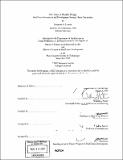The value of flexible design : real estate investment and development strategy under uncertainty
Author(s)
Loomis, Benjamin A. (Benjamin Alan), 1971-
DownloadFull printable version (13.34Mb)
Other Contributors
Massachusetts Institute of Technology. Dept. of Architecture.
Advisor
William L. Porter and David Geltner.
Terms of use
Metadata
Show full item recordAbstract
Utilizing recent research into building life cycle analysis and option valuation theory, this thesis develops an architectural methodology for analyzing buildings' "capacity for change," and economic models for valuing this capacity. Together these can be used to evaluate strategies for the design, investment, and development of new and existing buildings. Two hypothetical case studies illustrate the methods and models, and produce results which challenge conventional wisdom. One case study suggests that including a redevelopment option can increase the valuation of moderately performing assets by up to 25% over conventional discounted cash flow analysis, even when redevelopment is not economically feasible in the near term. The other case study fInds that when zoning allows, the design and construction of a building which can flexibly switch between multiple uses can be economically viable, even when substantial additional costs are incurred.
Description
Thesis (S.M. in Architectural Studies; and, S.M. in Real Estate Development)--Massachusetts Institute of Technology, Dept. of Architecture, 2003. Includes bibliographical references (p. 133-137).
Date issued
2003Department
Massachusetts Institute of Technology. Center for Real Estate; Massachusetts Institute of Technology. Department of ArchitecturePublisher
Massachusetts Institute of Technology
Keywords
Architecture.